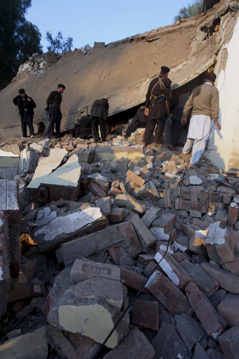As CPJ reports today, eight of the 42 journalists killed this year were on the job in Pakistan. It’s accurate to say the Pakistani victims were like most journalists killed worldwide: They were local journalists covering stories in their communities. But with Pakistan’s political and sectarian unrest aggravated by a decade-long war in neighboring Afghanistan, these journalists are covering a local story of global significance.

CPJ’s analysis shows that six of eight journalists who died this year in Pakistan were killed in suicide bombings or militant attacks. We also count more than 24 other journalists injured in suicide bombings.
Three reporters were killed in suicide attacks that can be linked to the broader conflict straddling the Pakistan-Afghanistan border. Pervez Khan and Abdul Wahab were among some 50 people killed in a double-suicide bomb attack in the Mohmand tribal district this month. Azamat Ali Bangash was killed in April when a suicide bomber attacked a food distribution line at a refugee camp near Orakzai. A prominent local reporter, Misri Khan, was assassinated in Hangu, a volatile town near the border with Afghanistan. Khan had been receiving threats from militant organizations before he was shot multiple times as he entered the press club building in Hangu, where he was president of the local branch of the Pakistan Federal Union of Journalists (PFUJ).
The deaths of three journalists outside the border area can also be linked to sectarian instability fomented in part by the Afghan conflict. In September, Ejaz Raisani died in the violent aftermath of a suicide bombing that targeted a Shiite demonstration in Quetta, capital of Baluchistan province. The violence left more than 60 people dead and another 185 injured, including several journalists. Also in Quetta, in April, Malik Arif died in a suicide bombing at a local hospital that killed at least eight people and injured many others, including five journalists. The reporters were covering a Shiite demonstration outside the hospital, where a prominent local Shiite bank manager had been taken after an attack. Somewhat set back from the Afghan border, Quetta serves as the rear headquarters for the Sunni-affiliated Taliban groups fighting in Afghanistan. Sunni conflict with other Islamic sects has long been a reality in Pakistan, but the strife seems to be on the rise with the country’s growing instability.
In Lahore, in separatist-minded Sindh province, Ejazul Haq a technician for a local cable station, was killed in May while working at the scene of an armed attack on a Muslim minority Ahmadi mosque. He was reporting live via cell phone from the scene, which was in his neighborhood. Colleagues at City-42 TV said the shots that had struck him could be heard on the air.
Only Ghulam Rasool Birhamani, abducted and tortured before he was killed execution-style in Sindh province, died covering a truly local story. He had recently written about the marriage of a 12-year-old girl to a 22-year-old man, offending some with his critical coverage.
Political and sectarian violence has long been a daily reality in Pakistan, but for media consumers outside the region it is overshadowed by the war in Afghanistan. Yet it’s astonishing to grasp the extent of violence within Pakistan’s borders. A chronology–Major Incidents of Terrorism-related Violence in Pakistan – 2010–is maintained by the Delhi-based Institute for Conflict Management, which monitors violence across South Asia. Though many Pakistanis are wary of data about their country that comes from India, ICM bases its list on media reports, and provides a reliable compilation. Scrolling down the list is mind-numbing.
